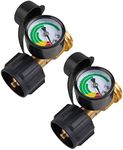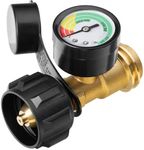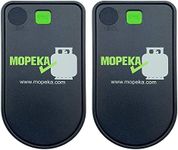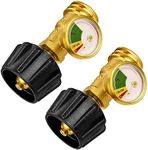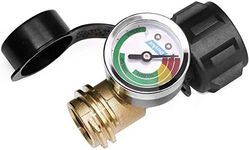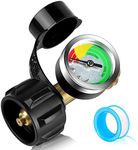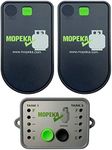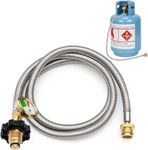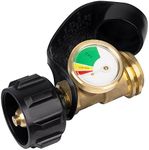Buying Guide for the Best Propane Tank Gauges
Choosing the right propane tank gauge can make your grilling, heating, or camping experience much safer and more convenient. A propane tank gauge helps you monitor the amount of gas left in your tank, so you don’t run out unexpectedly. When shopping for a gauge, it’s important to understand the different features and specifications to ensure you get one that fits your needs and works reliably with your equipment.CompatibilityCompatibility refers to whether the gauge will fit your specific propane tank and appliance connections. Propane tanks and appliances can have different types of fittings, such as Type 1 (ACME), POL, or QCC1. It’s important because a gauge that doesn’t fit your tank or hose won’t work at all. To navigate this, check what type of connection your tank and appliance use, and look for a gauge that matches. If you’re unsure, most home-use tanks in the US use the QCC1/Type 1 fitting, but always double-check. Picking the right compatibility ensures a secure fit and accurate readings.
Display TypeDisplay type describes how the gauge shows you the propane level. Some gauges use a simple color-coded dial (green, yellow, red), while others have more detailed pressure readings or digital displays. This is important because it affects how easily you can read and understand the gas level. If you want a quick glance to know if you’re running low, a color dial is simple and effective. If you prefer more precise information, a digital or pressure-based display might be better. Choose based on how much detail you want and how easy you want it to be to check your tank.
Measurement MethodThe measurement method is how the gauge determines how much propane is left. Some gauges measure pressure, while others use weight or temperature. Pressure-based gauges are common but can be less accurate in cold or hot weather, as pressure changes with temperature. Weight-based gauges are more accurate but may require lifting the tank. Temperature-sensitive gauges stick to the side of the tank and change color. Think about how you’ll use your tank: for frequent, precise monitoring, weight or temperature gauges might be better; for occasional checks, a pressure gauge is usually enough.
Durability and Weather ResistanceDurability and weather resistance refer to how well the gauge can handle outdoor conditions like rain, sun, and temperature changes. This is important because propane tanks are often used outside, and a gauge that isn’t weather-resistant may rust, crack, or stop working. Look for gauges made from sturdy materials like brass or stainless steel, and those labeled as weatherproof or rust-resistant. If you plan to leave your tank and gauge outside year-round, prioritize durability to ensure long-lasting performance.
Ease of InstallationEase of installation means how simple it is to attach the gauge to your tank and appliance. Some gauges screw on by hand without tools, while others might need wrenches or extra steps. This matters because a complicated installation can be frustrating and may lead to leaks if not done correctly. If you want a hassle-free experience, look for gauges advertised as tool-free or easy to install. If you’re comfortable with basic tools, you might not mind a more involved setup. Choose based on your comfort level and how often you plan to move or replace the gauge.
